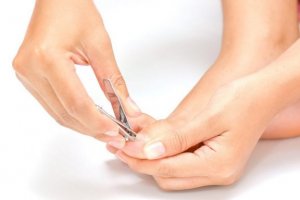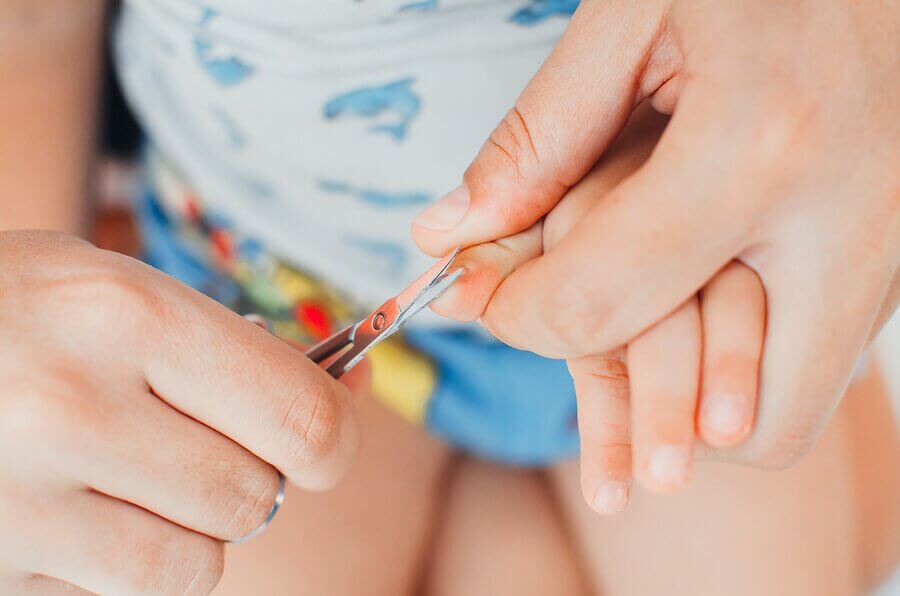How to Treat Ingrown Toenails

In this article, we’ll tell you how to treat ingrown toenails, which can develop for many reasons, either by improper nail cutting, hereditary conditions, or bad shoes.
In fact, it’s a very common issue that appears most often on toes. However, you can also get ingrown nails on your fingers.
Why do nails grow inward?
Ingrown nails happen because of an imbalance between the size of the nail and the growing skin around the nail. You should treat them as soon as you notice them. However, don’t worry too much because sometimes you can even treat ingrown toenails at home.
This is possible if the ingrown toenail shows no signs of infection such as swelling, warm to the touch, oozing or bad odor. The infection occurs when the nail penetrates the skin, making an easy entry for germs.

In these situations, you can try letting the nail grow. In addition, you can soak your feet in warm salt water. Then, dry them well with a clean towel, and apply an antiseptic solution to the affected area.
However, if you’re not sure you can treat ingrown toenails at home, you can have a podiatrist do the procedure. They’ll treat your nail with a local anesthetic. He’ll cut or remove the infected nail with a minor surgical procedure.
How to treat ingrown toenails
Soak, don’t dig into your skin
- Once you notice that you have an ingrown toenail, it’s time to act. However, never dig into your skin to try and remove the ingrown toenail, as it can further damage your skin and increase the risk of injury. Instead, soak the area with warm water and soap to soften your skin.
- Soak the affected area to make your nails soft and better eliminate the infection. This is the most dangerous part of ingrown toenails. Therefore, we recommend using salt water to reduce pain and inflammation. you can soak the area 3 to 4 times a day if you think it’s helping.
- Finally, put a bandage around the area to act as a barrier against bacteria. Keep in mind that you should cut your nails as straight as possible when it protrudes again. Cutting your nails wrong is the most common cause of ingrown nails, as you’ll see below.
Take some time to sit on the edge of the bathtub and wash the affected area. Also, make sure to use antibacterial soap.
If the nail is affected, it’s important to remove the edge of the nail that’s embedded in your skin, where it was previously numbed by an anesthesia. Then, you can follow an antibiotic treatment.
How can you prevent ingrown toenails?
Cut your nails correctly
Simply cutting your nails helps a lot to prevent ingrown toenails. With a safe nail clipper, cut them in a straight line so the corner of your nail is visible. If you cut your nails too short, you’ll make it easy for the corner to grow into your skin.

Wear comfortable shoes
We recommend wearing shoes and socks that aren’t too tight. In fact, this is another one of the main causes of ingrown toenails.
In this sense, to help prevent them from worsening, we suggest using those that have enough space for your toes. The right shoes are the ones that let your toes move easily.
Finally, we recommend that you never ignore infections, since it can spread and cause even more complications.
In this article, we’ll tell you how to treat ingrown toenails, which can develop for many reasons, either by improper nail cutting, hereditary conditions, or bad shoes.
In fact, it’s a very common issue that appears most often on toes. However, you can also get ingrown nails on your fingers.
Why do nails grow inward?
Ingrown nails happen because of an imbalance between the size of the nail and the growing skin around the nail. You should treat them as soon as you notice them. However, don’t worry too much because sometimes you can even treat ingrown toenails at home.
This is possible if the ingrown toenail shows no signs of infection such as swelling, warm to the touch, oozing or bad odor. The infection occurs when the nail penetrates the skin, making an easy entry for germs.

In these situations, you can try letting the nail grow. In addition, you can soak your feet in warm salt water. Then, dry them well with a clean towel, and apply an antiseptic solution to the affected area.
However, if you’re not sure you can treat ingrown toenails at home, you can have a podiatrist do the procedure. They’ll treat your nail with a local anesthetic. He’ll cut or remove the infected nail with a minor surgical procedure.
How to treat ingrown toenails
Soak, don’t dig into your skin
- Once you notice that you have an ingrown toenail, it’s time to act. However, never dig into your skin to try and remove the ingrown toenail, as it can further damage your skin and increase the risk of injury. Instead, soak the area with warm water and soap to soften your skin.
- Soak the affected area to make your nails soft and better eliminate the infection. This is the most dangerous part of ingrown toenails. Therefore, we recommend using salt water to reduce pain and inflammation. you can soak the area 3 to 4 times a day if you think it’s helping.
- Finally, put a bandage around the area to act as a barrier against bacteria. Keep in mind that you should cut your nails as straight as possible when it protrudes again. Cutting your nails wrong is the most common cause of ingrown nails, as you’ll see below.
Take some time to sit on the edge of the bathtub and wash the affected area. Also, make sure to use antibacterial soap.
If the nail is affected, it’s important to remove the edge of the nail that’s embedded in your skin, where it was previously numbed by an anesthesia. Then, you can follow an antibiotic treatment.
How can you prevent ingrown toenails?
Cut your nails correctly
Simply cutting your nails helps a lot to prevent ingrown toenails. With a safe nail clipper, cut them in a straight line so the corner of your nail is visible. If you cut your nails too short, you’ll make it easy for the corner to grow into your skin.

Wear comfortable shoes
We recommend wearing shoes and socks that aren’t too tight. In fact, this is another one of the main causes of ingrown toenails.
In this sense, to help prevent them from worsening, we suggest using those that have enough space for your toes. The right shoes are the ones that let your toes move easily.
Finally, we recommend that you never ignore infections, since it can spread and cause even more complications.
All cited sources were thoroughly reviewed by our team to ensure their quality, reliability, currency, and validity. The bibliography of this article was considered reliable and of academic or scientific accuracy.
- Daniel, C. R., Iorizzo, M., Tosti, A., & Piraccini, B. M. (2006). Ingrown toenails. Cutis, 78(6), 407–408. https://doi.org/10.4103/0378-6323.95442
- Haneke, E. (2012). Controversies in the treatment of ingrown nails. Dermatology Research and Practice. https://doi.org/10.1155/2012/783924
- Heidelbaugh, J. J., & Lee, H. (2009, February 15). Management of the ingrown toenail. American Family Physician. https://doi.org/10.1016/j.jmathb.2017.08.004
This text is provided for informational purposes only and does not replace consultation with a professional. If in doubt, consult your specialist.








